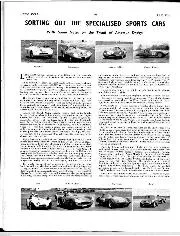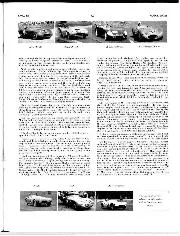

Sorting Out the Specialised Sports Cars
With Some Notes on the Trend of Amateur Design Last month we drew attention in the Editorial to the extremely healthy state of the Sport from the aspect of amateur-built…
THE idea of taking an open boat and converting it to a cabin cruiser is a very old one, but one always fascinating to the man whose desires in the matter of boats outruns his financial capabilities. There are, however, many things to be guarded against in this business of conversion and one of the greatest points to be watched is that nothing is undertaken on a hull that is not absolutely sound. Even in the case of a small cruiser of about 24ft. the cost of the materials and sundry other expenses of conversion, even when carried out by the owner, are apt to run to a rather higher figure than was at first expected. Therefore, a few pounds saved in the cost of the hull at the expense of its quality are a very false eeonomy. Of course, the idea of picking up a hull for 210 and superimposing some structure, which the owner may in the height of his enthusiasm imagine to be a very fine bit of work, is extremely attractive but one to be
guarded against. It is for this reason that ex-naval hulls are very popular for this class of work. Types available vary from 20 footers up to 50 feet or more, giving plenty of choice of size ; and the amazingly fine quality of material and workmanship in these craft are proverbial. They are all built of double skin teak and this means that, provided they have not been damaged in any way by collision or otherwise, they are practically everlasting. When fully considered, the price of a conversion can be seen to be a greater saving than at first realised. One is of course able to buy a 30 foot cruiser of good make complete, for something in the region of 2500 and, although these are undoubtedly thoroughly serviceable craft under reasonable conditions, the materials of which they are made naturally cannot, at the price, be up to the specification of the naval hull. We recently had the opportunity of going over some cruisers in course
of construction which had started life as open boats of this type, at Messrs. White & Co.’s yard at Fulham, where we were able to see the various stages of the work. This firm specializes in these jobs and has done so for many years. One interesting case was an ex-42-foot hull which had had 6 feet added to the length by altering the stern, and this completely disguised its origin. Most of the constructional work was finished, the craft awaiting the installation of the two Gardner Diesel engines. The actual cost of this boat without engines will come out to little over 21,000, and when one considers that a cruiser of this size (nearly 50ft.) complete with doubleskin teak hull would cost anything up to three times this figure without engines the enormous saving can be appreciated ; while the owner will know that he has something which will not only last a lifetime but be capable of going anywhere. Any who started reading this
article with ideas of home-made conversion at a few pounds may be rather disappointed by this talk of comparatively large sums, but we have mentioned this to show that the idea of converting is not as some people imagine a makeshift idea for those who can’t afford a proper vessel. The finished job is every bit as much a complete yacht as any built to the owner’s original plans. There are, of course, many smaller hulls suitable for this work as well as the 42 x 12 ft. which is definitely a large boat. The 40ft. x 10ft. makes an excellent job with sufficient room for 4 to 6 people according to the accommodation arranged, and the price completely converted by the firm mentioned above will come out at considerably less than R400 to which of course the cost of engines must be added. This so depends on the owner’s preference and also on his pocket it is extremely hard to lay down any definite price ; naturally the latest type of cold starting Diesel will differ rather drastically from the converted secondhand car engine, although the first cost is very often in inverse proport.on to the cost of upkeep and running. Again we have to consider the
man who is capable, or thinks he is, of doing all the constructional work himself on the hull, and there are certainly a great many cases of excellent jobs which have been carried out by amateurs resulting in a thoroughly sound cruiser which anybody would be glad to own. There are also, unfortunately, a considerable number of craft which although possibly the apple of their owner s’veye2are inclined/to be a
nasty jar to anyone who has an eye for form. One of the commonest mistakes is to try to give 6ft. or more head room in a small cruiser. The result is ungainly to look at and unseaworthy owing to the excess of top hamper in relation to the draft. When the point is reached where head room is going to spoil the lines and behaviour of the vessel it is time to give up the idea of being able to stand upright, and one must put up with sitting head room. Probably the best method of getting headroom in a small boat without spoiling the lines is the trunk cabin construction,which without apparently increasing the height, gives at least a portion of the ship in which there is room to stretch. Any tall person who has tried to struggle into his clothes under a 4ft. 6ins. high roof will agree that just a few inches in the centre line of the cabin where he can stand a little more upright will save many an oath and bruised cranium A question we have often been asked
is, “What about the ordinary ship’s lifeboat for conversion?” It is true that these hulls when they come out of service can be picked up for a few pounds but the ordinary ship’s lifeboat is naturally not built of anything like the same material as a hull built to Admiralty specifications, oak and elm being favourite ‘materials for this type of boat. They are often sound however, and if care is taken to see that the particular hull selected is really worth the work which is going to be required, it will make good cruiser. Those constructed of elm need the
greatest care in examination to see that they are sound as this wood, especially if the boats have been laid up or in fresh water for some time is liable to deteriorate. Another point against them is that they are clinker built, and therefore do not conform to the ideals of appearance demanded by the more fastidious. However, to the man who wants, in fact must have, a boat of some sort on which he can live for short periods and cannot afford anything better, there is a great deal to be said for the ordinary double ended clinker built 28ft. (or thereabouts) ship’s lifeboat. Again the result depends so much upon the ideas of the man who is planning the conversion. We have seen many converted ship’s lifeboats which more resembled a Noah’s Ark than a respectable cruiser, and although possibly serviceable, they must belong to a class of person with no eye what ever for line. Conversion carried out by a pukka boat builder will always look reasonable, as no firm which values its reputation will agree to carry out any plans which are going to offend the eye. But the amateur must be prepared to take a considerable amount of trouble if the finished
article is going to be satisfactory. We do not wish it to be imagined from these remarks that it is better for an amateur not to try and. do a.,,conversion, as some amateur built cruisers are quite up to the standard of a good boat builder ; but this is only in the case where the owner has considerable skill and is really prepared to take trouble. If the hull is worth having a cabin put on it, is worth planning properly and carrying out conscientiously, and if the prospective owner does not really feel capable of the job he would do better to get the work carried out by some firm who specializes in it. Although this may cost him a bit more at the time he will have no cause to regret it. A few pounds extra will be forgotten in time, but an ugly or unseaworthy boat is a curse to the end.